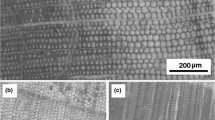Abstract
Using constant heat sap flow sensors, xylem water fluxes in ten tree species and two liana species were monitored for 5–10 days during the beginning of the wet season in May, 1993. For a subset of the trees, a branch was also monitored at the top of the crown for 5 days. Xylem flux (J S) was related diurnally in all plants to vapor pressure deficit (D) measured within the upper-third of the canopy, and to incoming shortwave radiation R S above the canopy. Cross-correlation analysis was used to estimate time lags between diurnal patterns of J S and D or R S, and between J S in stems and branches. The maximum correlation coefficient from cross-correlation of J S with R S (range=0.57–0.92) was often higher than the maximum of J S with D (range=0.43–0.89), indicating that diurnal J S was more dependent on R S than D. Time lags (lag corresponding to maximum correlation) of J S at stem-base with D was shorter (0–45 min) than with radiation (5–115 min), highly variable within a species, and uncorrelated to the height or exposure of tree crowns or liana in the canopy. On a stand level, not accounting for the diel lag between stem sap flux and canopy flux resulted in errors in estimated canopy transpiration of up to 30%.
Similar content being viewed by others
Author information
Authors and Affiliations
Additional information
Received: 19 October 1998 / Accepted: 8 June 1999
Rights and permissions
About this article
Cite this article
Phillips, N., Oren, R., Zimmermann, R. et al. Temporal patterns of water flux in trees and lianas in a Panamanian moist forest. Trees 14, 116–123 (1999). https://doi.org/10.1007/s004680050216
Issue Date:
DOI: https://doi.org/10.1007/s004680050216




